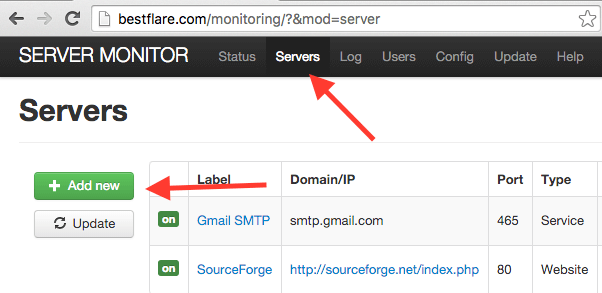Application uptime is crucial for business operation, and as Infrastructure support, you must be equipped with the required monitoring tool for proactive action.
If you are working in a large organization, then most probably you will have some enterprise tool, which you are obliged to use it.
However, for small to medium businesses – you may think of having Open Source as a free solution for Web URL & Ports monitoring.
In this article, I will talk about how to monitor URL and Service Ports with an Open Source tool based on PHP – PHP Server Monitor.
Some of the monitoring possibilities
- Monitor Web URL
- Monitor Port number
- Search for a string on website and markdown if not found
- Option to try for configured threshold before alerting
- Define response timeout value
- Get notified through email, SMS, Jabber, Telegram, Pushover
Pre-requisite
- Web Server – Apache, Nginx (I will consider Apache for this demo)
- PHP 5.5.9+ or PHP 7.0.8+
- PHP-MySQL
- MySQL
- CURL
If you already have a pre-requisite on your server, including Database, then you may jump to the “Install PHP Server Monitor” section below.
Install Apache, PHP, MySQL, CURL
- Login into a server where you intend to set up the monitoring
- Open the SSH Terminal
- Execute below yum command to install
yum install httpd php mysql-server curl php-mysql
- Start Apache & MySQL services
service mysqld start
service httpd start
Setup Database
It requires a database to store the monitoring matrix. Let’s start setting up MySQL by creating a database, user & password. If it’s fresh MySQL installation, then it’s recommended to go through securing procedure by executing
/usr/bin/mysql_secure_installation
- Follow the instruction on the screen. Actually, you can have Y for all.
- Restart MySQL service
It’s time to create the database and grant the privileges.
[root@Chandan yum.repos.d]# mysql -u root -p Enter password: Welcome to the MySQL monitor. Commands end with ; or g. Your MySQL connection id is 2 Server version: 5.1.73 Source distribution Copyright (c) 2000, 2013, Oracle and/or its affiliates. All rights reserved. Oracle is a registered trademark of Oracle Corporation and/or its affiliates. Other names may be trademarks of their respective owners. Type 'help;' or 'h' for help. Type 'c' to clear the current input statement. mysql> create database CHANDAN; Query OK, 1 row affected (0.00 sec) mysql> create user CHANDAN@localhost; Query OK, 0 rows affected (0.00 sec) mysql> set password for CHANDAN@localhost=PASSWORD("CHANDAN"); Query OK, 0 rows affected (0.00 sec) mysql> grant all privileges on CHANDAN.* to CHANDAN@localhost identified by 'CHANDAN'; Query OK, 0 rows affected (0.00 sec) mysql> flush privileges; Query OK, 0 rows affected (0.00 sec) mysql> exit Bye [root@Chandan yum.repos.d]#
For demo purposes, I have kept username, password & database as “CHANDAN”. Please change it accordingly.
Install PHP Server Monitor
You may create a new folder “monitoring” under /opt to keep the tool package.
- cd /opt
- mkdir monitoring
- cd monitoring
- Download the latest version from here
Or you can directly pull the zip file from the server using wget command
- unzip the downloaded zip file
unzip phpservermon-3.1.1.zip
- Copy the extracted folder to your Apache DocumentRoot. If installed at default location then it would be /var/www/html
cp –rp phpservermon-3.1.1 /var/www/html
- Let’s rename the folder from phpservermon-3.1.1 to monitoring (this is optional though)
mv phpservermon-3.1.1 monitoring
Let’s begin installation by accessing a web server URL with monitoring URI. If you were doing on localhost, then it would be http://localhost/monitoring/install.php
- Click on “Let’s go.”

- Enter the database information
- Click on “Save configuration.”

- Enter user details to create an account for Monitor Administration
- Click on “Install”

- It will take a few seconds, and you will see “SUCCESS” confirmation.

Great, so now your “PHP Server Monitor” setup is done, and it’s time to configure some monitoring.
- Click on “Go to your monitor.”
- Enter the username and password and click on “Login.”

You will be redirected to the “Status” page, where you will see pre-defined two monitoring. Don’t worry – you can delete them.

- Let’s set up a URL monitoring. Click on “Servers” menu on the top
- Click on “Add new”

- Enter the required information and click on “Save.”

- You will notice that newly added monitoring is displayed under the “Status” page.

Configure cronjob
To have status updated periodically, cronjob must be running. You can run them every 5 minutes or whatever suits you. You may refer my article on setting up a crontab if not sure.
*/05 * * * * root /usr/bin/php /var/www/html/monitoring/cron/status.cron.php
This great tool also gives you Latency (average) and uptime report in a graph by an hour, day, or week.
- Go to Status and click on the desired label.

Go ahead and add some monitoring to get notified when something goes down. Alternatively, you may try a cloud-based monitoring solution for your websites.

















